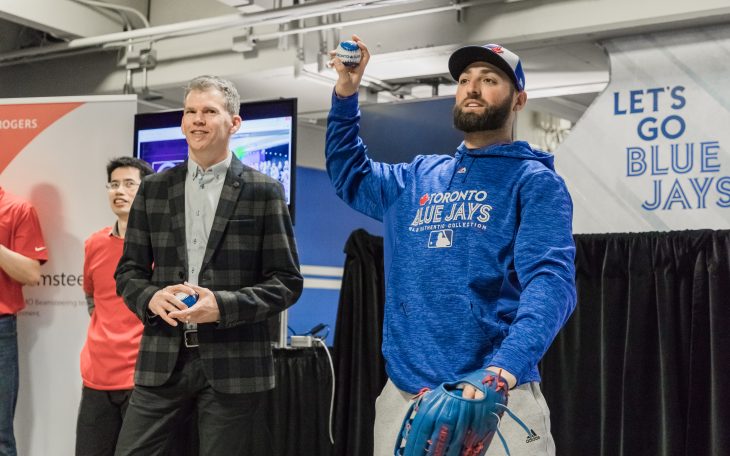
TORONTO – Rogers Communications has unveiled a multi-year network plan which includes working with Ericsson to bring Canadians even closer to 5G.
At an event Monday morning at the Rogers Centre in Toronto, the companies demonstrated live what 5G will be able to do in the not-too-distant future. Participants wore augmented reality (AR) gear to toss a baseball back and forth, virtually shopped in a retail store complete with a haptic feedback device on their hands, and controlled robots showing real-time responsiveness over the internet.
Rogers also demonstrated Quad-band Licensed Assisted Access (LAA) on Gigabit LTE to show how LAA (4.5G, if you’re keeping score) provides high bandwidth, simultaneously across several devices. The company described the Rogers Centre, home to the Toronto Blue Jays, as “an ideal real-world testing environment”, noting it regularly hosts thousands of connected devices, features dense concrete, and high peak data usage. Rogers has already installed hundreds of small cells under the dome.
The company said Monday its network plan includes the continued rollout of its Gigabit LTE network with technology and equipment that is based on the latest global 3GPP standards, including massive MIMO (multiple input, multiple output antennas – where there are 64 mini antennas in one of the new, little MIMO enclosures Rogers had on display), four-carrier aggregation and 256 QAM. It will boost and densify its network with small cells and macro sites across the country, and, working with Ericsson, pledged to trial 5G in Toronto, Ottawa, and other unnamed select cities over the next year.
5G commercial deployment isn’t contemplated until 2020 as the standards set by the 3GPP body aren’t due until June, said Rogers CTO Jorge Fernandes Monday. Even so, with all the work companies like Rogers and Ericsson and many others are doing in their labs and in testing, “5G will deliver the real-time economy,” he added.
While 4G was all about boosting speed, 5G is more about dramatic improvements in capacity and latency (but yes, speeds will get better). “It’s the ultra low latency capability and the usage of technologies such as edge computing and network slicing… (that is) going to enable a new world of possibilities,” added Fernandes. It will also require more spectrum and a redeployment of its existing spectrum resources in some cases, too.
One of the demonstrations on hand Monday was a tiny, two wheeled robot purpose built to demonstrate how the extremely low latency which will be delivered by 5G will cause dramatic improvements – especially to enterprise customers.
Rogers engineers were feeding the robot (pictured) commands over the internet and it balanced itself very well with latency of just one millisecond. Bumping that up to 10 ms and the robot stood but was slightly shakier. At 30 ms, it fell over. 4G latency is in the 50 ms range. 3G was 300 ms. The average human reaction time is 250 ms.
“Personally, I believe that the enterprise, the business development will be where the real opportunities come from. I think that’s where the creativity will happen." – Jorge Fernandes, Rogers
While we tend concentrate on the consumer segment and what 5G might mean to our phones (you’ll be able to download a 4K movie in 40 seconds rather than 40 hours), Fernandes sees big opportunity in the enterprise side of the business. “Personally, I believe that the enterprise, the business development will be where the real opportunities come from. I think that’s where the creativity will happen,” he said.
“From the consumer point of view, initially all you will see is higher throughput and the throughput is always limited, in a way, by the kinds of applications that you have… There’s only so much throughput you can get on a  handset to watch a video. That’s not really a relevant application. It’s when you start seeing virtual reality, or smart cities – that’s where I think you’ll see really exciting, new innovations come from.”
handset to watch a video. That’s not really a relevant application. It’s when you start seeing virtual reality, or smart cities – that’s where I think you’ll see really exciting, new innovations come from.”
Another demonstration was a virtual reality store, where a customer, from home, can shop with their VR headset – and with the right haptic gear on their hand (this one was a Tactai touch device) are supposed to feel what they’re buying.
Part of the secret sauce of 5G is, according to the engineers, the “network slicing” which has to be done for each application. In the VR store example, audio, video and haptic each rides on a different slice of the network to work in real time which means the network must be smart enough to switch to another of the now great many antennas if needed to maintain a guaranteed quality of service.
This type of network smarts – which is also powered by artificial intelligence because this all won’t work without advanced AI, too – is what will enable wide deployment of things like autonomous vehicles that can see around blind corners for that cyclist and more demanding applications such as remote surgery – “and other things of which we haven’t yet dreamed,” said Fernandes.
The opportunities, and challenges, are simply far greater and more complex than delivering more video to our handsets.
In top photo: Blue Jays' centre fielder Kevin Pillar helped demonstrate how 5G will help drive things like augmented reality baseball.



